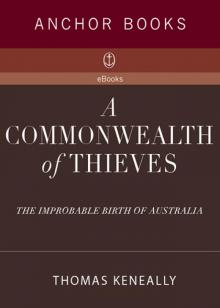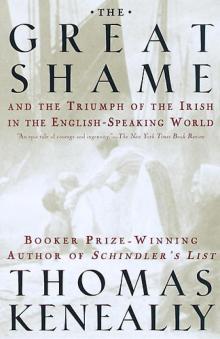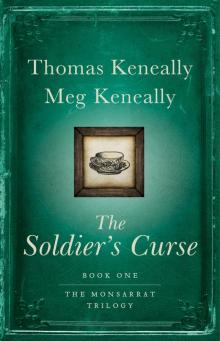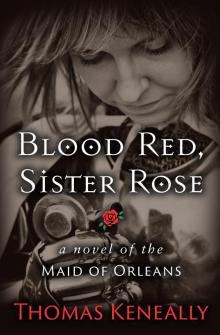- Home
- Thomas Keneally
Australians Page 6
Australians Read online
Page 6
On Campbell’s receiving ship, the prisoner was stripped of the vermin-infested clothes he had worn in Newgate or elsewhere in the kingdom, bathed, and held for four days quarantine. The high death rate on Campbell’s ships and, ultimately, on less well-administered hulks moored in Portsmouth and Plymouth, seems to have been partially the result of diseases prisoners had contracted originally in the common wards of city and county gaols and brought to the hulks with them. ‘The ships at Woolwich are as sweet as any parlour in the kingdom,’ Campbell argued with some pride, and he had the grace to live near them—at Blackheath just behind Greenwich. But though Campbell had a reputation for decency, the Act of Parliament setting up the hulks called for prisoners to be ‘fed and sustained with bread and any coarse and inferior food’ as a symbol of their shame, and urged that misbehaviour be punished by ‘whipping, or other moderate punishment’.
There was on top of that the hulks’ peculiar below-decks dimness, the frock of sewage and waste which adorned the water around them, and the horror of being locked down at night on the cold prison deck and abandoned to the worst instincts of the established criminal cliques. The British thought of the hulks as a temporary expedient, but they would not be able to get rid of their floating prisons in the Thames and elsewhere until 1853—indeed, hulks would make an ominous appearance in Dickens’s Great Expectations.
Periodically reacting to complaints from their constituents, London’s members of parliament and city aldermen kept telling government the prisoners on the hulks should be transported anywhere convenient—to the East or West Indies, Canada or Nova Scotia, Florida or the Falklands. The mayor and corporation of the City of London thought as bad as were the mischiefs so severely felt already, the ‘rapid and alarming accumulation of convicts within the kingdom’ involved consequences in city prisons and in hulks no human wisdom could foresee.
For by the end of the American war it was obvious British prisons and hulks could not handle the condemned or cause them to disappear. Each prisoner on the hulks cost government £38 a year, and his labour was not worth that. The question was not whether transportation would occur but where.
Yet except for the rebellious North American colonies, no one place seemed the right destination for transportees.
GET RID OF THEM—BUT WHERE?
The question of a destination for the condemned took up a lot of time.
The most significant witness to appear before the Commons Committee on Colonies, in 1779, set up while government was trying to relieve gaol pressure all over Britain, was Sir Joseph Banks, the great naturalist, commentator and society figure.
Even though in the journal of his voyage as a young scientist with Cook, Banks described Botany Bay on the New South Wales coast as barren, he urged the committee to consider that it might be suitable for transportation, and that there was sufficient fertile soil to sustain a European settlement. From there, too, escape would be difficult, he said. The climate was mild, as in the south of France. There were no savage animals or hostile natives. The ‘Indians’ around Botany Bay he estimated at hardly more than fifty.
Sir Joseph Banks was asked whether he thought land for settlement might be acquired from the Aborigines ‘by Cession or Purchase’. Banks said he thought not, that there was nothing you could give the Aborigines in return for their soil. He told the committee that the blacks were blithely nomadic and would ‘speedily abandon’ whatever land was needed. The concept of New South Wales as terra nullius, no man’s land, was born.
In the end, the Commons Committee left the question of transportation destinations open, but recommended the building of two penitentiaries, where prisoners would be kept in solitary confinement with hard labour. By 1786, however, no progress had been made on building the penitentiaries and the government had definitely decided to begin transportation again. Crime levels had jumped because of the discharge of members of the army and navy after the war in America. Home Secretary Lord Sydney was left to write, ‘The more I consider the matter, the greater difficulty I see in disposing of these people.’
Botany Bay in immensely remote New South Wales, on a coast Endeavour had visited in 1770, also had an eloquent proponent in a former midshipman of Cook’s, the miscreant James Maria Magra (or Matra) who allegedly had cut Orton’s ears one drunken night. But he did not see Botany Bay chiefly as a destination for transportees. At the time he sailed with Cook, he had been financially secure due to his New York colonial family’s wealth, but having remained loyal to the Crown in the American war, he had lost all that. He had returned to London from New York in 1781, where he found a great number of fellow American Empire Loyalist refugees living in squalor. Britain was doing little for them, and Magra drafted a 1783 pamphlet addressed to the British government, A Proposal for Establishing a Settlement in New South Wales to Atone for the Loss of our American Colonies. American Empire Loyalists should be sent as free settlers to New South Wales, and wives should be supplied to them if necessary from amongst the natives of New Caledonia or Tahiti. ‘Settlement could be a centre for trade with East Asia or a wartime base for attack on the Dutch colonies of Malaya . . . And thus two objects of the most desirable and beautiful union will be permanently blended: economy to the public, and humanity to the individual.’ Without mentioning convicts, Magra nonetheless brought attention to New South Wales/Botany Bay as a potential destination for awkward people.
Though Sir Joseph Banks promoted Magra’s proposal to the government, the incumbent Tories soon fell and the Whigs came to power, and Lord Sydney, a recently ennobled political operator and Kentish squire in his early fifties, inherited the Home Office, including concern for prisons and colonial affairs. Sympathetic to those loyal subjects who had lost their American lands, savings and standing, he was already involved in organising a new home for American loyalists in Nova Scotia, where there would grow a city named in his honour.
On the question of prisons and hulks, though, Sydney remained under pressure from all directions. On 9 December 1784, he wrote to the mayor of Hull, who had asked for the removal of his city’s convicts to the hulks, saying that not a person more could be at present admitted to them. Sydney answered similarly to a request from Oxford, and others from a range of counties. Sydney, born Thomas Townshend, already had a solid political career behind him, having been Secretary of War in a previous government and then Home Secretary under both Shelburne and Pitt. He was thought to be a good man who lived an orderly life at his house in Chislehurst, though Oliver Goldsmith, the author and activist, depicted him as the sort of lesser talent with whom great spirits such as Edmund Burke had to deign to negotiate.
At the end of 1785, Prime Minister Pitt and Lord Sydney and his Undersecretary, the former naval purser Evan Nepean, were still looking for a plausible scheme of transportation. They considered Africa, specifically a tract of country on the west coast between 20 and 30 degrees south latitude, near the mouth of the Das Voltas (Orange) River where there were copper deposits. Convicts could be shipped out in slaving vessels which would then proceed up the coast to pick up their more accustomed cargo of African slaves to take to America and the West Indies. The many American families who were still anxious to live under British rule could also be sent to Das Voltas and serve as the discipliners and employers of the convicts. In preparation, the government sloop Nautilus was sent to survey the southern Atlantic coast of Africa, but its ultimate report was that the country was barren, waterless, hopeless.
The government also considered a settlement on the Caffre (Kaffir) coast around the Cape. But fears of aggrieving the Dutch in Cape Town made the British pull back.
In March 1786, Londoners and their aldermen yet again petitioned against the unsatisfactory solution represented by the hulks. The aldermen reminded the government that demobilised and unemployed soldiers and sailors could make a mob, and imbued with the fancy American ideas of the rights of man would set convicts free and burn the hulks. The hulks had brought the risk of mayhem and uprising, as well
as shipboard epidemics, to within a longboat’s reach of shore.
At last, in August 1786, Cabinet plumped for New South Wales, the preposterously distant coast Cook had charted sixteen years past. Londoners rejoiced that a decision had been made to resume transportation. They believed it would mean an end to the river hulks.
A DISCREET OFFICER
The man the government chose to ‘take upon him the command of this rabble’ of convicts was a 49-year-old Royal Navy post-captain named Arthur Phillip, an old shipmate of the Home Office Undersecretary, Evan Nepean. The fact that Phillip had been a sailor since the age of thirteen and had no experience at all of the British penal system did not worry the Home Office. Lord Sydney wanted any robust and adaptable fellow to mount the flotilla and empty the hulks and prisons for him.
A neighbour of Phillip’s in the New Forest, Sir George Rose, Secretary of the Treasury, was involved in the costings of the enterprise, and he supported Phillip’s appointment, which Phillip does not seem to have hesitated in accepting. Many officers might have thought it potentially dangerous and unrewarding.
Lord Howe at the Admiralty had written to Lord Sydney of the Home Office on 3 September 1786: ‘I cannot say the little knowledge I have of Captain Phillip would have led me to select him for a service of this complicated nature.’ But Sydney liked and admired professional officers like Phillip, whom he rightly considered the journeymen of Empire. Yet he was demanding of Phillip a remarkable spectrum of gifts. The man had to undertake a huge navigation and command a number of ships packed with criminals, and on arrival at Botany Bay in New South Wales was required to implement a completely novel enterprise for the Crown, an unprecedented penal and society-making experiment. This blended mission of being commodore not of two or three but eleven ships, as well as captain-general of huge and unvisited territories, and gaoler-in-chief in the netherworld was something for which normal naval service could only dimly prepare anyone. The fact that Sydney thought he could recruit any old reliable officer for it might say more about the pressure he was under than his faith in Phillip. Due to the vulgar urgings of domestic politics, Prime Minister Pitt and Lord Sydney were sending to the ends of the earth a reputable but not glittering fellow, in command of many vessels stocked not with naturalists and artists but with Britain’s sinners.
The founding document of this enterprise for Lord Sydney and for Captain Phillip was called, unremarkably, The Heads of a Plan, and was devised in Sydney’s office by Phillip’s friend Evan Nepean. It called for the appointment of ‘a discreet officer’, and that had been achieved. The term ‘discreet’ had as rich a series of associations and meanings then as now, but one wonders if it included the idea that Phillip was to keep watch for French incursions into the south-west Pacific, as well as be prison-master. For Phillip, in the past, had been a spy against the French. The Heads then concentrated on the business of transportation to New South Wales, rather than on any commercial benefit arising from the new place. New South Wales was a country which, by the temperateness of the climate, ‘connected with the remoteness of its situation (from whence it is hardly possible for persons to return without permission)’, seemed ‘peculiarly adapted’ to deal with the increase of felons in the kingdom, and especially in London. The Heads covered the process of transportation, the taking on board of two companies of marines to form a military establishment, the provision of rations, and the collection of supplies and livestock on the way at Rio de Janeiro and the Cape of Good Hope.
Towards the end of this Plan for settling Botany Bay, Nepean raised the issue of financial and strategic benefits which might arise from the cultivation of the New Zealand flax plant and from the tall trees already growing on Norfolk Island, a place Cook had discovered some 1600 kilometres out in the Pacific from Botany Bay, where a proportion of the felons were to be settled. British manufacturers, wrote Nepean, had claimed that a cable ten inches (25 cm) thick and made of New Zealand flax was superior to an eighteen-inch (46 cm) cable made from European material. Additionally, the Heads mentioned the procuring of New Zealand masts and ship timber for the fleets in India.
There has been a great deal of argument about whether this commercial thought was tacked onto the penal plan, or was the real purpose of the whole operation. But the document declares itself at its opening sentence: ‘Heads of a plan for effectually disposing of convicts.’ And if the proposed penal settlement in the south-west Pacific were to become a trading post, it would violate the chartered monopoly of the immensely powerful East India Company, and upset the Company’s trade with Canton and in India. The East India Company’s principal, Francis Baring, would quite early complain of ‘the serpent we are nursing at Botany Bay’.
It seemed that His Majesty’s government desired New South Wales far more as a prison than as a great port, or as an opening for British trade. Phillip was thus, in the strictest penal sense, to be a governor, and not an apostle of British commerce.
THE MYSTERIES OF PHILLIP
To his convicts, Arthur Phillip would later convey the very breath of civil magisterium, even though his early childhood might not have been much more socially elevated than some of theirs. His mother, Elizabeth Breech, had first been married to a sailor named Herbert, who died while still in his twenties of a fever caught during his duty on the Jamaica station. Elizabeth then married Jacob Phillip, a German, a ‘native of Frankfurt’ and a teacher of languages. Arthur Phillip was born in October 1738, in the family house in Bread Street in the City of London, not necessarily an address of privilege. He was admitted to the charity orphan school at the Royal Hospital for Seamen at Greenwich, apparently as Herbert’s son rather than Phillip’s, in 1751. The school was for the sons of poor seamen, ‘training them up to a seafaring life’. Going thus to Greenwich was a deception which might have added further secretiveness to the boy’s aloof nature.
Arthur Phillip’s apprenticeship had begun in 1753 in the squalid, grease-laden, profane atmosphere of a whaler built for the Greenland whale fishery. Just after his seventeenth birthday, war—later to be called the Seven Years War—was declared between France and Britain and he entered the Royal Navy as a captain’s servant. He experienced the violence of cannonry in an inconclusive battle to save the British-garrisoned island of Minorca. Then, having passed his lieutenant’s exam, as a junior officer off Havana in 1761 he survived both Spanish artillery and a wet season in which malaria, yellow fever, cholera, typhus and dysentery killed off seven thousand sailors and soldiers engaged in the campaign.
This prepared Phillip for elevation, even though he lacked the powerful connections so important to young officers. His character in his early twenties combined a dry humour with reserve, efficiency and intellectual hunger. To temper his authoritarian streak he had common sense and was not fast to anger. It is hard to imagine him on a loud stampede through foreign streets, looking for liquor or women.
On 19 July 1763, the Seven Years War having been fought, in St Augustine’s, Watling Street, Lieutenant Phillip married Margaret Denison, the widow of a glove and wine merchant, and fifteen to sixteen years older than he was. He does not seem to have been a young man aflame with passion. With the war over he was on half-pay, and the couple lived in Hampton Court for two years, but then went to rusticate at Lyndhurst in the New Forest in Dorset, on Margaret’s estate of 22 acres (8.9 hectares), named Vernals. Phillip ran their property as a dairy farm, kept their horses and grew fruit and vegetables. But ‘some circumstances occurred’ which led to a formal indenture of separation signed by the couple in April 1769. It stated that they had ‘lately lived separate and apart’.
Now Phillip applied himself to his alternate vocation. He began to spend time in France as a spy for the Home Office or Admiralty. With a gift for languages and his German coloration he was good at it, but it was an ungrateful business, and Phillip felt he needed to accelerate his naval career. The Portuguese government approached the Admiralty and asked them to second some good officers to help in their fight with
Spain over a disputed area, a region known as the Debatable Lands, which ran northward from the estuary of the River Plate on the south-eastern coast of South America. As a token of their claim, the Portuguese had created a colony at the Plate, across the estuary from Buenos Aires, and named it Colonia do Sacramento. The Admiralty recommended Lieutenant Phillip to its Portuguese friends. Collecting his new ship, Nossa Senhora de Belém, on the banks of Lisbon’s Tagus River, he quickly added Portuguese to the French and German he could already speak.
Phillip got on well with the Portuguese viceroy in Rio de Janeiro, Marquis de Lavradio, who found him a committed combatant against the Spanish coastguard and naval vessels. But in 1776, the Portuguese started to negotiate with the Spanish. Lavradio had already reported to the Portuguese court that Phillip’s health was delicate but that he never complained, ‘except when he had nothing special to do for the Royal Service’. It was true that many of Phillip’s illnesses were associated with a kind of ardent waiting for action to occur, or else with circumstances in which he conducted dangerous work out of the direct gaze of the Admiralty. Ambition was his most restless appetite.

 Confederates
Confederates Flying Hero Class
Flying Hero Class Gossip From the Forest
Gossip From the Forest Schindler's List
Schindler's List Bring Larks and Heroes
Bring Larks and Heroes Australians: Flappers to Vietnam
Australians: Flappers to Vietnam The People's Train
The People's Train Crimes of the Father
Crimes of the Father A Family Madness
A Family Madness A Commonwealth of Thieves
A Commonwealth of Thieves Ned Kelly and the City of Bees
Ned Kelly and the City of Bees A River Town
A River Town Bettany's Book
Bettany's Book Blood Red, Sister Rose: A Novel of the Maid of Orleans
Blood Red, Sister Rose: A Novel of the Maid of Orleans Victim of the Aurora
Victim of the Aurora American Scoundrel American Scoundrel American Scoundrel
American Scoundrel American Scoundrel American Scoundrel Three Cheers for the Paraclete
Three Cheers for the Paraclete Australians: Origins to Eureka: 1
Australians: Origins to Eureka: 1 The Power Game
The Power Game The Chant Of Jimmie Blacksmith
The Chant Of Jimmie Blacksmith The Daughters of Mars
The Daughters of Mars Searching for Schindler
Searching for Schindler The Great Shame: And the Triumph of the Irish in the English-Speaking World
The Great Shame: And the Triumph of the Irish in the English-Speaking World Abraham Lincoln
Abraham Lincoln The Widow and Her Hero
The Widow and Her Hero Eureka to the Diggers
Eureka to the Diggers Shame and the Captives
Shame and the Captives The Survivor
The Survivor Jacko: The Great Intruder
Jacko: The Great Intruder The Book of Science and Antiquities
The Book of Science and Antiquities Homebush Boy
Homebush Boy The Playmaker
The Playmaker To Asmara: A Novel of Africa
To Asmara: A Novel of Africa A Woman of the Inner Sea
A Woman of the Inner Sea The Tyrant's Novel
The Tyrant's Novel Australians
Australians Schindler's Ark
Schindler's Ark The Soldier's Curse
The Soldier's Curse Australians, Volume 3
Australians, Volume 3 Blood Red, Sister Rose
Blood Red, Sister Rose A Victim of the Aurora
A Victim of the Aurora The Unmourned
The Unmourned Australians, Volume 2
Australians, Volume 2 To Asmara
To Asmara